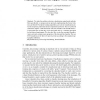20 search results - page 1 / 4 » The Return of the Cryptographic Boomerang |
TIT
2011
12 years 11 months ago
2011
—The boomerang analysis, together with its offspring the amplified boomerang analysis and the rectangle analysis, are techniques that are widely used in the analysis of block ci...
TMC
2012
11 years 7 months ago
2012
—We present the boomerang protocol to efficiently retain information at a particular geographic location in a sparse network of highly mobile nodes without using infrastructure ...
CRYPTO
2007
Springer
13 years 8 months ago
2007
Springer
Abstract. Since Crypto 2004, hash functions have been the target of many attacks which showed that several well-known functions such as SHA-0 or MD5 can no longer be considered sec...
ACISP
2009
Springer
13 years 11 months ago
2009
Springer
Abstract. In this paper, we study GF-NLFSR, a Generalized Unbalanced Feistel Network (GUFN) which can be considered as an extension of the outer function FO of the KASUMI block cip...
KDD
2006
ACM
14 years 5 months ago
2006
ACM
We study the problem of private classification using kernel methods. More specifically, we propose private protocols implementing the Kernel Adatron and Kernel Perceptron learning ...


